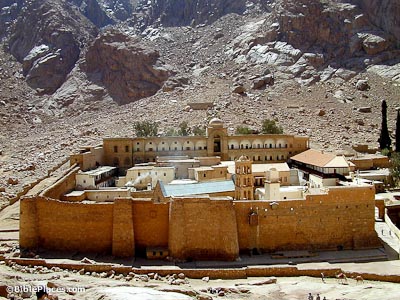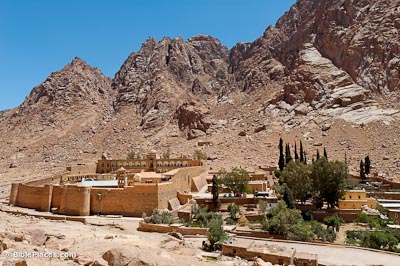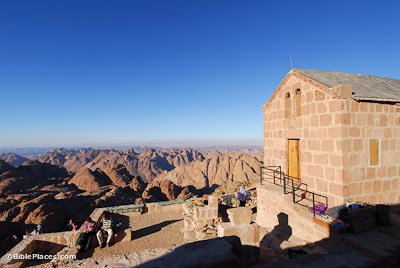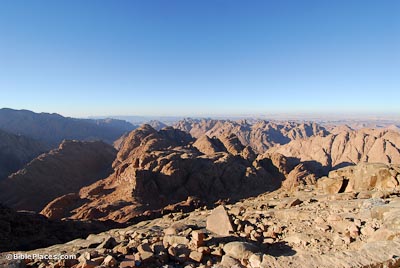The monastery at the base of Jebel Musa preserves the tradition from the Byzantine period of identifying this as Mount Sinai. Named after a saint who was martyred in Egypt in AD 307, the monastery has a library with the second finest collection of manuscripts in the world (after the Vatican), including 3,500 manuscripts and 2,000 scrolls. Most of these are in Greek and were copied by the monks of this monastery. In 1844, the German scholar Friedrich von Tischendorf discovered Codex Sinaiticus here, one of the earliest copies of the Bible (4th c. AD).
Jebel Musa (Mt. Sinai?)
Plain of el-Raha
Wadi el-Deir connects Jebel Musa to the Plain of el-Raha. Raha means “rest” and according to tradition, this is the area where the Israelites camped and the golden calf was forged (Exod 32). Nearby are the tomb of Sheikh Harun (Aaron) and the chapel of the golden calf.
Jebel Musa
The monastery sits at an elevation of 5,150 feet (1,570 meters). The mountain of Jebel Musa rises to 7,498 feet in elevation (2,285 m). Jebel Musa is Arabic for “the mountain of Moses.” The mountain is ascended by 3,700 steps carved by a monk (known as the “steps of repentance”). The path leads past the “Spring of Moses” and a chapel dedicated to the Virgin Mary. Closer to the summit is the “Spring of Elijah” where the prophet is alleged to have hidden when running from Jezebel (1 Kgs 19).
The Summit
At the summit of Jebel Musa is the chapel to the Holy Trinity. This chapel was rebuilt in 1934 on the ruins of a 4th–5th century church. The interior of the chapel is decorated with frescoes from the life of Moses. Slightly to the west of the chapel is a small mosque built in the 12th century. Beneath this mosque is the traditional cave where Moses spent 40 days (Exod 24) and where the Lord appeared to Elijah (I Kgs 19).
Location of Mt. Sinai
Scripture does not give a clear indication of the location of Mt. Sinai and for that reason, scholars differ widely over where it is to be located. The traditional location, Jebel Musa, is in southern Sinai, but some believe that this is too distant from the Nile Delta for the Israelites to have traveled in the time described in Scripture (preferring a location in northern or central Sinai). Others believe that Mt. Sinai was on the other side of the Gulf of Aqaba in what is Saudi Arabia today.
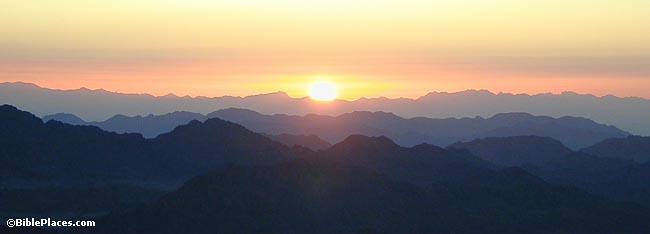
Sunrise from the Top
If you ever visit Jebel Musa, the program will almost certainly include a 2 a.m. ascent up the mountain in order to watch the sunrise. One way to avoid this is to carry a tent and sleeping bag and spend the night on the mountain. Sleeping is difficult with the wind and cold and becomes impossible when the noisy tourists begin arriving long before daybreak. The sunrise looks like this. Is it worth all the effort? You decide.

Download all of our Egypt photos!
$34.00 $49.99 FREE SHIPPING
Related Websites
For historical images of the monastery, see Life in the Holy Land. For a Bible chapters related to this site, see Exodus 3 and 19.
Mount Sinai, Egypt (World Pilgrimage Guide) Details many of the traditions that surround the site.
Mount Sinai (The Jewish Magazine) A well-written travel journal of a visitor to Jebel Musa.
Thoughts on Jebel al-Lawz and the Location of Mt. Sinai (Associates for Biblical Research) An article by Bryant Wood about the location of Mt. Sinai based on biblical evidence.
Mount Sinai (Bible Mapper) A nice topographical map is the highlight here.
Mount Sinai—Why You Absolutely Need God’s Word First (Wayne Stiles) A few pictures and a map accompany this brief devotional.
Proposed Locations of Mt. Sinai (Biblical Archaeology Review) This overview was originally a sidebar in an article; it reviews a number of sources and where they choose to locate Mount Sinai.
Your Ultimate Guide to Jabal Musa (Egypt Uncovered) A vistor’s guide, including some overview and history.
Saint Catherine’s Monastery: A Visitor’s Guide (PlanetWare) Good for more than just those planning an imminent visit, this page features numerous helpful photographs, as well as a plan of the Church of the Transfiguration.
Explore the Monastery (Geographia) Provides further information about St. Catherine’s Monastery on the linked pages. Features an interactive picture of the site which indicates the location of various features (such as the library and archives).
Art and Architecture of Saint Catherine’s Monastery at Mount Sinai (Khan Academy) A bit of a different perspective on some of what dwells within the walls of the monastery.
Library (official page) This is the official homepage for the library at Saint Catherine’s Monastery. It has plenty to explore.
The Library of Saint Catherine’s Monastery (Ministry of Tourism and Antiquities) A brief introduction to the library’s history.
